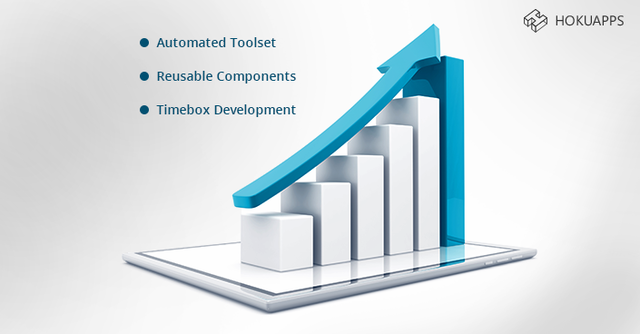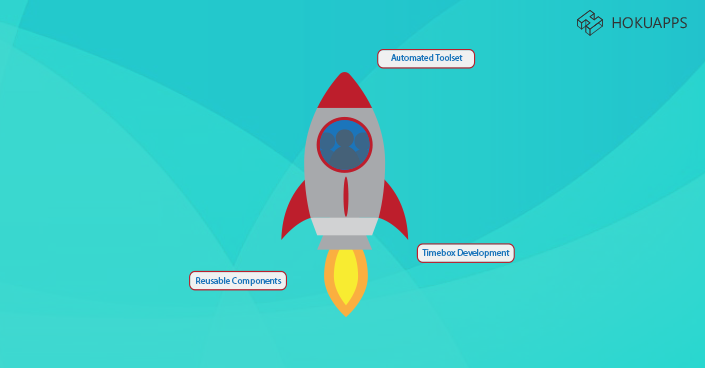- Products
- Solutions
- Services
- Resources
- Customer Success
- Company
- Sign In
- Contact Us

Digital Transformation enabler helping enterprises evolve by connecting technology
Take a look at upcoming webinars and special events
HokuApps news and media coverage
Be with the best. Solve real problems
Get in touch with our experts here
Explore our extensive collection of online resources here
Information and insight on transformation to the Digital Workplace
Quick Guides provide concise information on a variety of topics
Discover the essence of HokuApps’ products
Learn all about HokuApps’ cutting-edge enterprise mobility technology

There are several benefits of the HokuApps enterprise RAD platform. The primary benefit being that the HokuApps RAD platform expedites the app delivery process. It enables developers to create applications using a single code base that can adapt to any web and mobile platform with cross-platform portability. Moreover, the HokuApps enterprise RAD platform allows users to develop functional interactive prototypes of the application within a few hours, providing clients and business stakeholders with the opportunity to stay involved in the entire development stage.
Moreover, with the HokuApps enterprise RAD platform, developers do not need to know any specific language in its entirety or possess additional technical experience when working with RAD models. This, in turn, allows developers with different skill levels contribute to a RAD platform project. The reason for this being the pre-built functionality of this low code development platform which allows a drag and drop method of app creation.
Listed below are the key elements that every business is equipped with by choosing to partner with HokuApps Rapid Application Development Platform as a project’s systems development methodology. They contribute to the overall success of HokuApps enterprise RAD platform in these particular ways:
Automated toolset – RAD platforms use automated tools and techniques to achieve greater speed and higher quality. These tools play a pivotal role in accelerating the app development process and help to mitigate problems that occur in other traditional existing models. A tool’s effectiveness is contingent upon how well it is integrated with a central repository – that supports RAD prototyping, data and process modeling and code reusability. These features, in turn, will expedite the app development process. Thus, RAD platform projects depend upon automated toolset and its potential to optimize the systems development functions. The success of a RAD platform project is also dependent upon CASE tools deployed by developers. Computer Aided Software Engineering tools or CASE tools are prominently used in RAD platform projects. CASE tools offer automated assistance to help determine if both data models and process models can be integrated and if logical models can evolve into physical models.
Professional developers use CASE tools to automate software development life cycle (SDLC) activities. These tools simplify various stages of the SDLC. For example, some developers may be involved in the testing process while others may be involved in supervisory roles or other management and maintenance tasks. CASE tools allow developers to perform each of these tasks efficiently. It is imperative that project team members select the appropriate CASE toolset that supports modeling, prototyping and code reusability. These tools, thus, have wider applicability within the app development lifecycle and professional developers make full use of CASE tools when developing various methodologies, including the RAD approach. Therefore, it is only with a powerful CASE toolset that developers are able to do away with manual coding and are able to implement Rapid Application Development irrespective of the programming language or platform.
Reusable components – The second most important aspect of a Rapid Application Development platform is not the availability of reusable and testable software components but the degree to those can be re-used within the RAD platform. Some of the more common reusable components are – system management environment (SME) and systems development environment (SDE). Before commencement of the RAD project, technical components need to be identified. Subsequently, it is critical to complete the activities around Client/Server methodology that support the deployment of these components.

Timebox development – In the timebox process model, the basic unit of development is a time box. Each timebox is of a fixed duration and can be divided into stages or phases. A stage or phase is approximately of the same duration and the task or activities pertaining to it are performed by a set of dedicated team members. Since the HokuApps RAD platform follows this iterative development approach, the development team can focus on building the core of the system and implement enhancements in subsequent releases. In other words, during every iteration, the enhancements or refinements proposed and developed can be fit into the time box. The time box model supports multiple iterations simultaneously. The time box process model thus ensures greater frequency with each delivery, which in turn reduces the cycle time for each delivery. The benefits of RAD platform outweigh all traditional app development methods.
There are other factors that are taken into consideration before deploying an enterprise RAD platform that can guarantee the success of a RAD project.
To ensure the success of a RAD project, enterprises can select a RAD platform that supports APIs in its entirety since APIs feature prominently in every business application and architecture. By deploying a RAD platform that focuses on APIs, businesses are able to import data from any service and bind it to the software’ UI components. Moreover, enterprise RAD platforms should always allow developers to easily create, publish and discover APIs.

It is critical that enterprise RAD platforms support flexible authentication and authorization mechanisms. Business applications necessitate robust security control mechanisms to secure users and allow them to perform various tasks within the application. Therefore, RAD platforms must always provide integration support for prominent identity management systems like LDAP, AD, OAuth, and SSO.
Hence, it is almost undebatable that by adopting the HokuApps RAD platform, enterprises gain significant operational efficiencies and greater business outcomes.